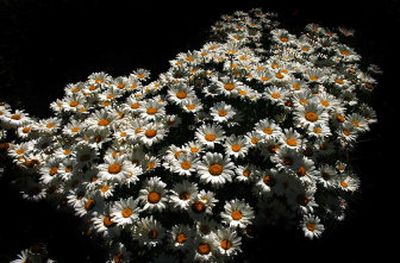Shasta daisies at their best

I read that Shasta daisies bloom all summer with deadheading, but mine puts on one full show then it’s all over. They only have a few small buds on the lower stems, everything else is the same height and bloom the same week or so.
Also, I’m starting a compost pile and have been told not to add the peony cuttings. Why not?
Thanks.
Eleanor Hill, Spokane
Shasta daisies do put on their best show right about now. The rest of the summer will be very light. The words “blooms all summer” can mean a lot of different things in plant descriptions. The tall forms of Shasta daisies characteristically carry their flowers on tall stems. Some of the dwarf varieties, like “Alaska,” will mound more, giving the impression of flowers all over the plant.
There is no reason you can’t compost peony trimmings. The only things that can’t go into compost piles are table scraps, meat, fats, dairy products, dog and cat manure and really seedy weeds.
Master Gardeners can help
This might be something that you can’t help me with but I’m not sure where else to ask.
I’m going to be moving to Okanogan, Wash., from Spokane – by way of Virginia and Iowa – soon and have a yard full of flowers. I have no clue what some of them are.
My grandmother was a Master Gardener in Virginia so I have some background from helping her, but I need resources for learning how to care for and identify the plants. Also, I have a very large plot that is meant for a vegetable garden but have only assisted my parents with theirs and have no clue how to start my own or what – if anything – I can plant this late in the year.
Hope you can help!
Chrystal Wakeham
You are in luck. Your very best resource will be the Okanogan County Master Gardeners right in Okanogan. The address is 149 Third North and the phone is (509) 422-7245. In general Okanogan is drier than Spokane but otherwise the growing conditions are very similar. The trick you will have with your Midwest and East Coast experience will be to deal with the area’s lack of humidity. That does change how you plan your watering and the kind of diseases you will see. Things that did well in the sun there may not fare as well because our skies are very clear in the summer intensifying the sunlight. Take clippings of your plants into the Okanogan folks and have them identify them. Before you leave Spokane though, stop by the Master Gardener Plant Clinic (222 N. Havana St.) and pick up a copy of Landscape Plants for the Inland Northwest. This is the only book written for the area. Also pick up a copy of the Sunset Western Garden Book as it is a great reference for gardening in the West.
Just remember the Sunset zones are different from the USDA zones.